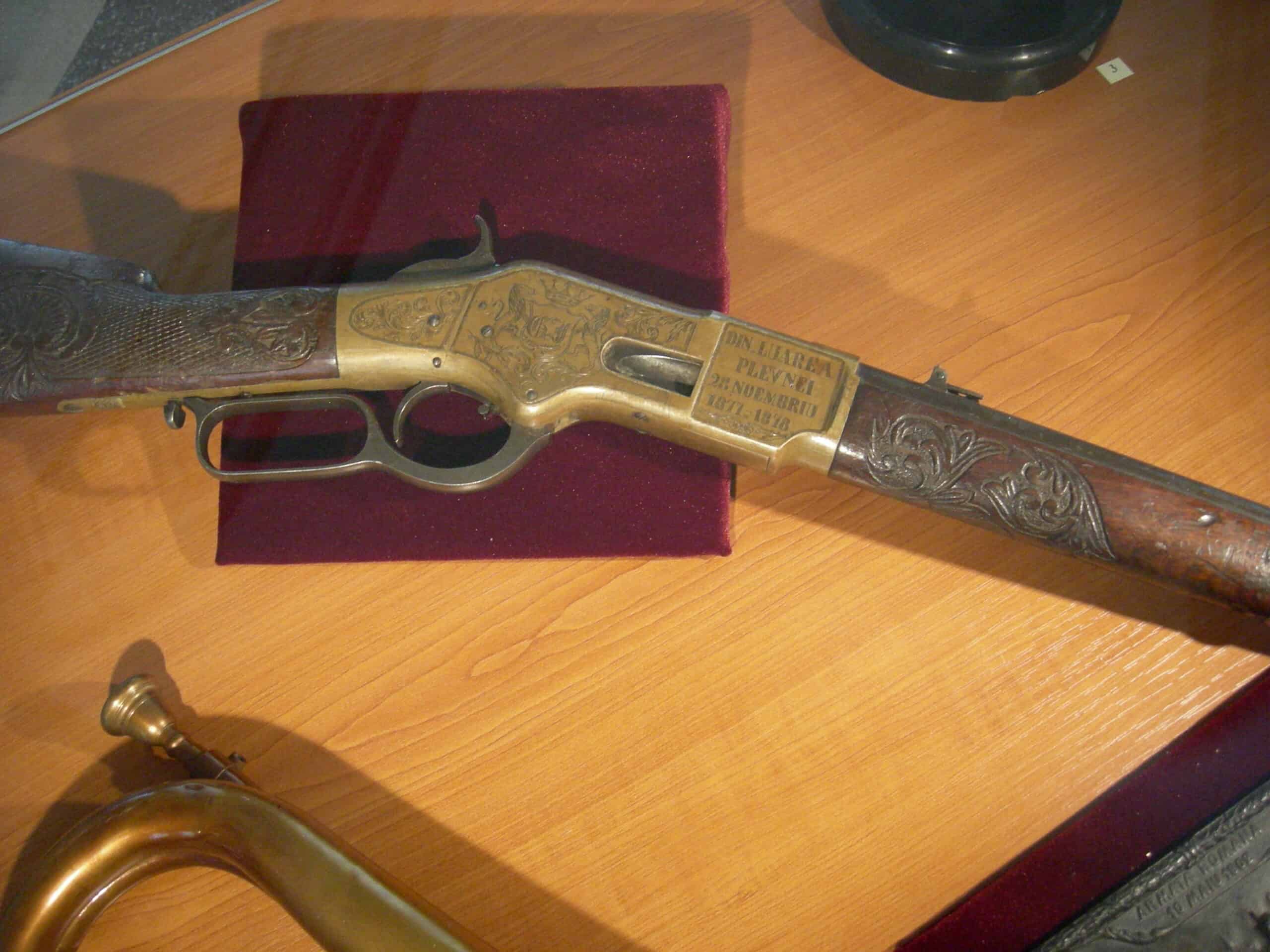While many gun manufacturers will advertise certain models of their guns as “the Gun That Won the West!” no single gun can be described as the sole player in the Western expansion of the United States. The expansion of the United States into its western areas took place over a long period of several decades and most guns don’t see a production run that long. When a gun is released to the public and military, the manufacturer typically begins engineering its replacement almost immediately.
Western expansion in the United States was mostly spurred by the Industrial Revolution, which brought many advancements in firearms engineering. The diverse western settlers used guns for many tasks, such as sustenance, defense, conquest, protection, law enforcement, and, of course, law-breaking. However, while the Old West is consistently associated with guns and sharpshooting, the reality of the time was much different. Most Western territories, and especially Southwestern ones had strict gun laws. Still, everyone owned guns because they needed them to survive in the Let’s examine ten of the most common and popular guns of the cowboy age and see what famous cowboys and cowgirls wielded them.
To determine which guns belonged on this list, we assessed other published lists by magazines and publications that focused on information about the Old West. We also looked at reputable sources like the Smithsonian Magazine to get a better handle on the state of affairs in the Old West regarding guns. Then, we researched the specific gun models we chose, including looking at manufacturer specifications and historical information. (Also See 23 Iconic Photos of Life in the Wild West)
Hawken Plains Rifle

At the beginning of the Western expansion, the most prominent were the long, slender Pennsylvania rifles. However, these rifles didn’t have enough stopping power to deal with the large, dangerous game present in the Western territories. Thus, the Hawken Plains Rifle was born. Plains rifles were shorter, heavier, and had more stopping power, making them effective against large game and dangerous animals. Several prominent gunsmiths, such as H.E. Dimick and J.P. Gemmer turned out plains-style rifles. However, it was the Hawken design that would become the most prominent in the Old West and the standard against which all other plains rifle designs were held.
Designed by Samuel and Jacob Hawken, these models were heavy, large bored, full or half-stock muzzleloader rifles. They were better suited for horseback use than many other rifles at the time, which was crucial for cowboys and other Western settlers who needed to use their guns while riding horses. The gun had a long production run, being manufactured from the early 1820s until the 1870s. The sales of this gun peaked in the mid-1850s, but it remained popular for many years after its peak. This gun was a favorite rifle for many famous cowboys, lawmen, and outlaws, such as Kit Carson, Jim Bridger, Mariano Modena, Jedediah Smith, John C. Fremont, and William F. “Buffalo Bill” Cody.
In the modern day, these guns remain popular with gun collectors. They are nearly synonymous with the Old West and Western expansion. It was most popular pre-Civil War, and after the Civil War, it was phased out in favor of more modern rifle designs.
Colt Paterson Revolver

Revolver, patent model. Colt Paterson Revolver. AF-251084.
Many people associate the Old West with gunslingers armed with six-shot revolvers, holstered at their hip, ready for a quick-draw duel. However, the Colt Paterson Revolver—a five-shot revolver—was one of the most influential guns of the age. Patented in 1836, it was a cap and ball, single-action revolver, and represented the first successful practical model for a revolving pistol. However, despite these illustrious claims to fame, it was not a successful business venture for Samuel Colt by any measure. After production finally began in 1837, only about 2850 of the guns were ultimately produced for commercial sale. However, the design revolutionized revolver designs at the time and influenced the production of more popular revolvers of the age. The gun was named for its production location, Paterson, New Jersey.
There were several variations of the gun, such as the pocket-sized “Baby” Paterson. The Texas Paterson, a .36 caliber, long-barreled revolver was used in battles against the Comanches by the early Texas Rangers. Variations of the gun also served in the Mexican-American War from 1846–1848, and in a limited capacity was present in the Second Seminole War in Florida. It was somewhat popular in the gold camps in California. Its production ran until 1842, which was a relatively short period for gun manufacturers. Due to the relative unpopularity of the original gun design, we couldn’t find any big names who preferred to wield it. However, its influence on revolver designs and engineering can still be felt today. Thus, despite its lack of popularity and fame, it’s hard to deny that the Colt Paterson Revolver was one of the most influential guns of the Old West.
Colt 1849 Pocket Model
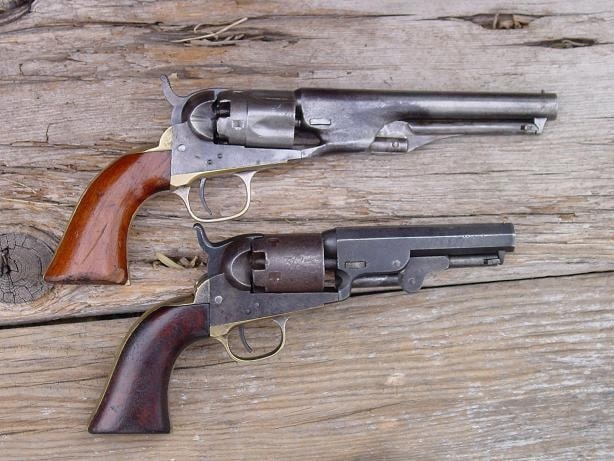
Revolvers were popular in the West. However, while most people think of larger, hip-holstered revolvers when they think of cowboys, pocket revolvers were highly popular as well. The Colt 1849 Pocket Model is another five-shot revolver made by Samuel Colt. It is Colt’s best-selling revolver of the 19th century, and possibly Colt’s best-selling revolver worldwide. While a pocket model gun might seem like it lacks the stopping power to become popular, this gun was extremely popular with both civilians and the military. Unlike the Paterson, the 1849 Pocket Model was produced in massive numbers. Around 330,000 left the factory lines between 1850 and 1873 and thousands of units were purchased in the pre-Civil War West. It was highly coveted by Western settlers, especially in the gold camps in California, where the gun would sell for several times the factory retail price.
The design began as the brainchild of Samuel Colt. He recognized the need for a small, lightweight sidearm for Western settlers that could easily accompany the heavier plains rifles. As he designed this new gun, he realized he could eliminate several manufacturing steps and reduce the number of parts required by making the gun smaller than his larger Dragoon revolvers that were his standard at the time. The resulting Colt 1849 Pocket Model was popular with everyone. Miners, gamblers, merchants, lawmen, women of the night, and soldiers alike adored the small form factor, 0.31-caliber revolver. This gun was so popular that it made Samuel Colt famous and ensured that his business would stay afloat for many years.
Colt 1851 Navy Revolver
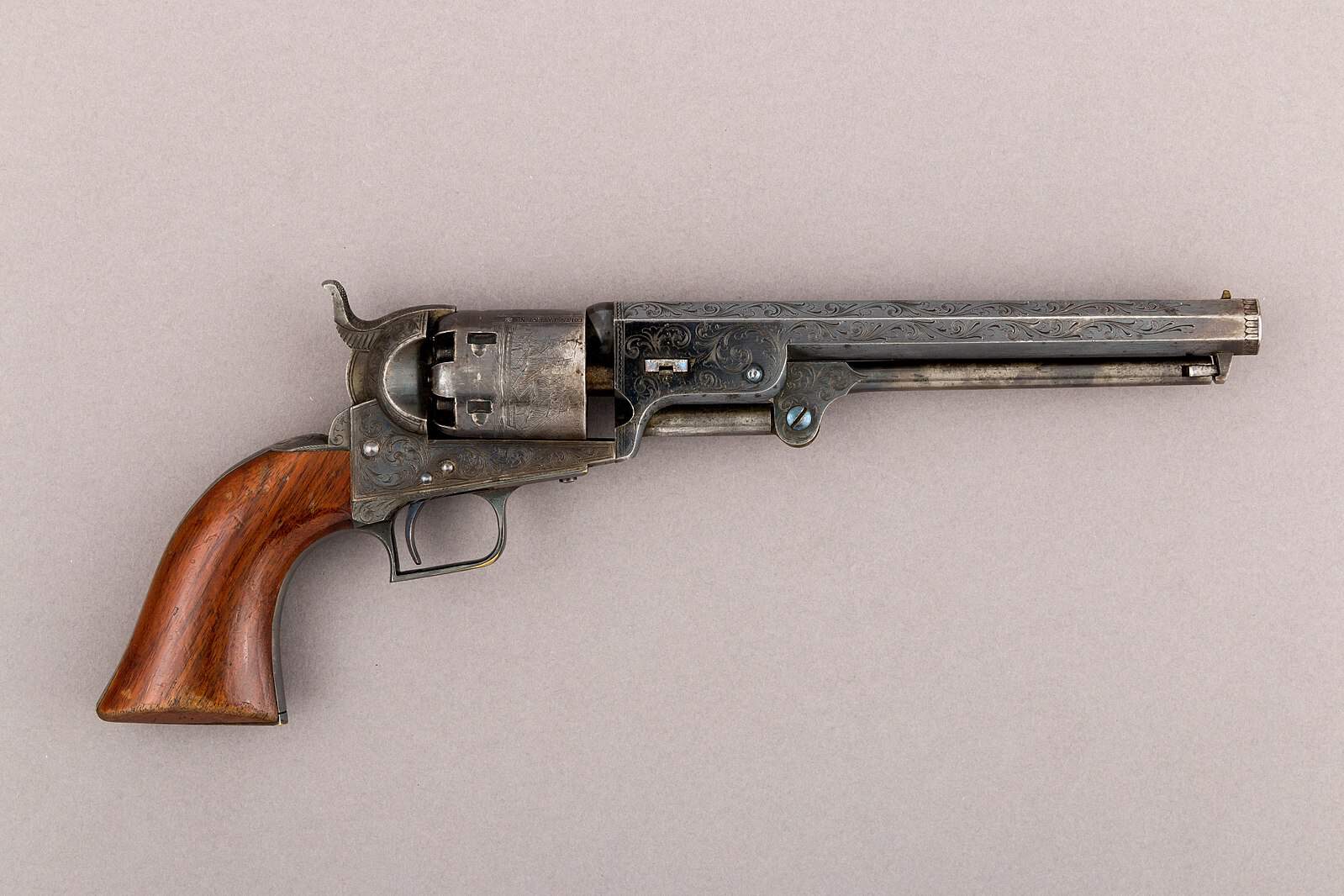
We hope you’re not too sick of hearing about revolvers because revolving guns were the name of the game when it came to Old West sidearms. The Colt 1851 Navy Revolver is one of the world’s most famous revolvers. It’s widely regarded as being one of the best-balanced and smoothest-handling belt-sized revolvers of the caplock gun era. This gun was preferred by many big names in the Wild West but is probably best known as the favorite sidearm of James Butler “Wild Bill” Hickok.
Other famous users of the Colt 1851 Navy Revolver included the James-Younger outlaw gang, the Texas Rangers, the Pinkerton detectives, Tiburcio Vasquez, John Wesley Hardin, Major Frank North and the Pawnee Scouts, and Robert E. Lee when he was stationed in Antebellum, Texas before the Civil War. Like the 1849 Pocket Model, the 1851 Navy Revolver was a popular, coveted gun in the California goldfields, and it sold for many times its retail price in these camps.
While fewer were produced than the 1849 Pocket Model, a staggering 250,000 of these guns were manufactured between 1850 and 1873. It was a 0.36-caliber six-shooter, most popular before the introduction of metallic cartridges. However, during the 1870s, a modernization effort was performed on the gun, and a handful of the guns were converted to take 0.38-caliber metallic cartridges. Despite more modern revolvers being available as the century progressed, this gun remained in use by civilians and the military well into the end of the 1800s. Unfortunately, modernizing the guns didn’t work out well, and it was more effective to engineer new guns that took modern cartridges.
1860 Colt Army Revolver
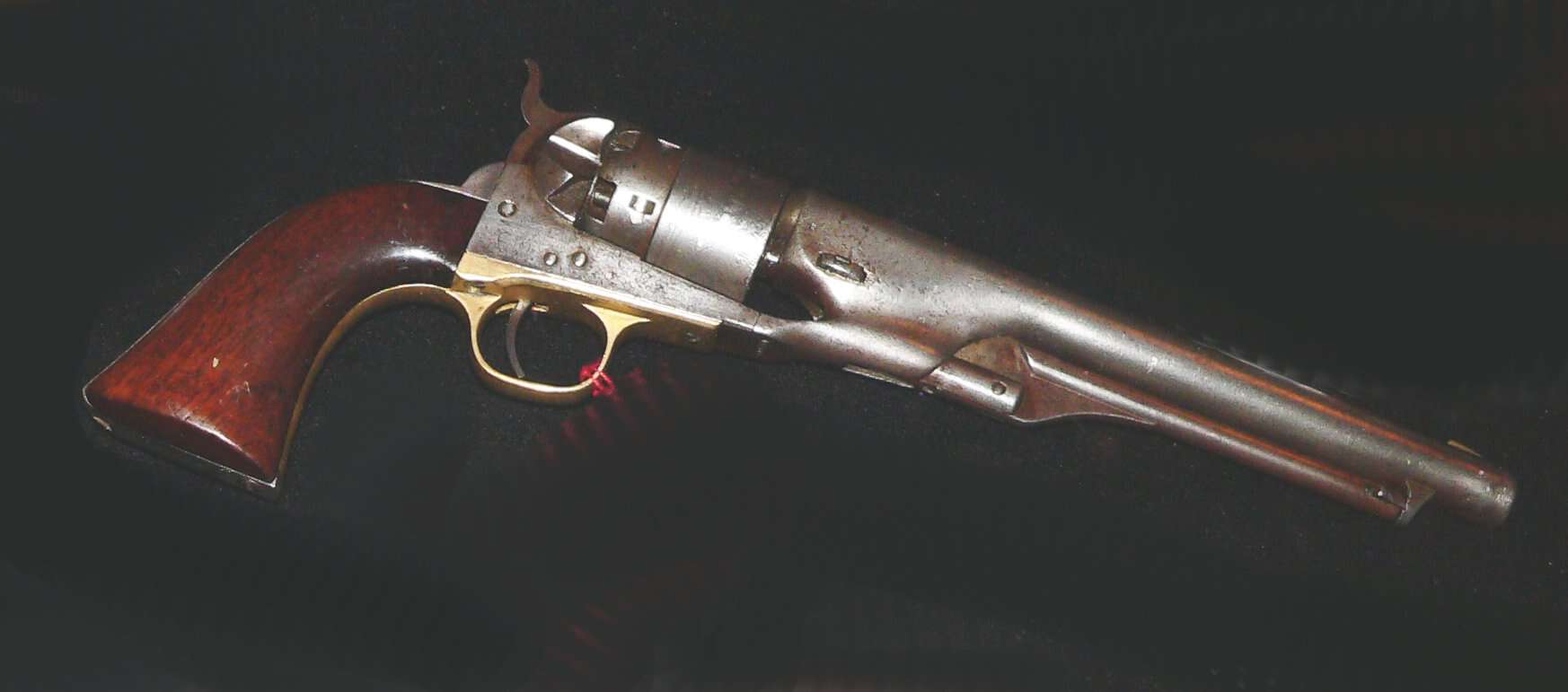
While it may not be the “best balanced” or “smoothest handling” percussion revolver in the world, the 1860 Colt Army Revolver is widely considered to be history’s prime specimen of percussion revolvers. This model is Colt’s third-most-produced percussion handgun of all time. It succeeded the Dragoon revolvers and was lighter and easier to carry and handle than its predecessor. It was an immediate success upon release and was produced in massive numbers, with 200,500 units manufactured. Of those produced, 127,156 were purchased by the Union Army during the Civil War. Thus, it became the primary revolver used by federal troops during the conflict. The original percussion design used a caplock mechanism. However, it was later modernized and converted to use metallic cartridges when those became more popular.
This gun has a good feel and is easily holstered at the hip, making it comfortable to carry and good for situations where you would need quick access to your gun. It is almost as powerful as the Dragoon revolver, despite being smaller and lighter, making it an excellent replacement for people who were previously using Dragoons. Most of the guns produced had an 8-inch barrel, but a few thousand were made with 7.5-inch barrels. It was a favored gun for many big names in the West, as well as the military. For the U.S. Cavalry and the Texas Rangers, the gun was a standard issue for their members. It was also used by major Western figures, such as John Wesley Hardin, the James brothers, Sam Bass, and Porter Rockwell.
Springfield Trapdoor Rifle
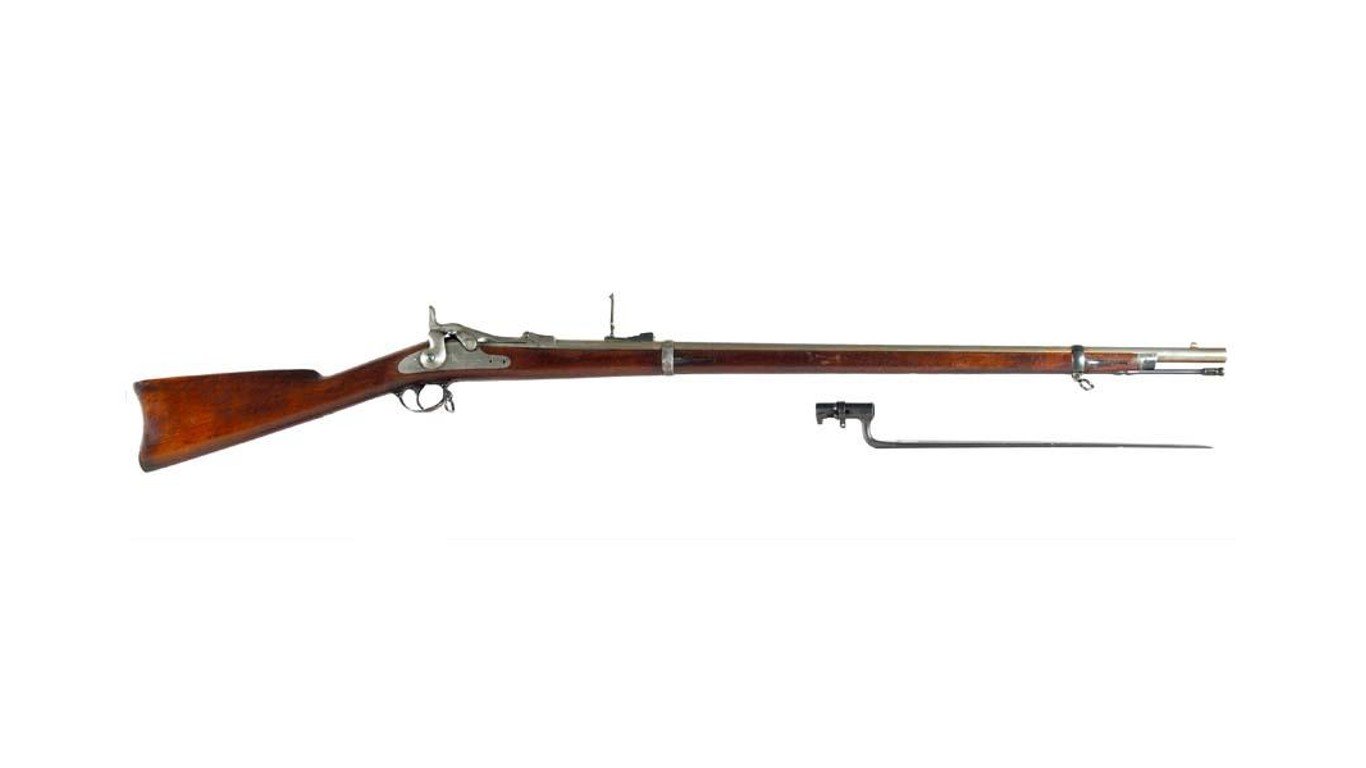
Rifle, trapdoor. 1979.0425.165.
The Springfield Trapdoor Rifle wasn’t called that until the 1873 model of the gun was introduced, which had a trapdoor and compartment in the butt stock that users to utilize to store cleaning tools and a broken shell extractor. Before that, it was typically referred to as the Allin Conversion Model or the needle gun, due to its unusually long firing pin. As the name suggests, it started its life as an Allin-converted Civil War muzzleloader. The gun was initially chambered to use a 0.58-caliber rimfire, metallic cartridge. Eventually, the gun was remodeled into the 2nd Model Allin Conversion Model 1866, which had a sleeved barrel and took 0.50–0.70-caliber centerfire cartridges, which were a bit more modern and powerful.
The gun was present at many military engagements against Native Americans along Wyoming’s Bozeman Trail, most notably the Hayfield and Wagon Box fights in 1867. However, it was better known as being an excellent buffalo-hunting gun. Many hide hunters adored it for its efficiency in killing large game. William F. “Buffalo Bill” Cody was known to kill huge animals, especially buffalo, with his 0.50–0.70 Allin. He considered the gun to be “beautiful, but deadly.” Cody named his gun “Lucretia Borgia” after the infamous Rennaissance-era Italian noblewoman.
The gun came in both rifle and carbine configurations. Both configurations were used against the Northern Plains Native Americans, Apaches, Comanches, and other Southwestern Native Americans. It was the primary weapon for the army responsible for fighting Native Americans until the mid-1890s. The last recorded use of the gun in a major military engagement was at Wounded Knee in 1890.
Winchester Model 1866 Rifle
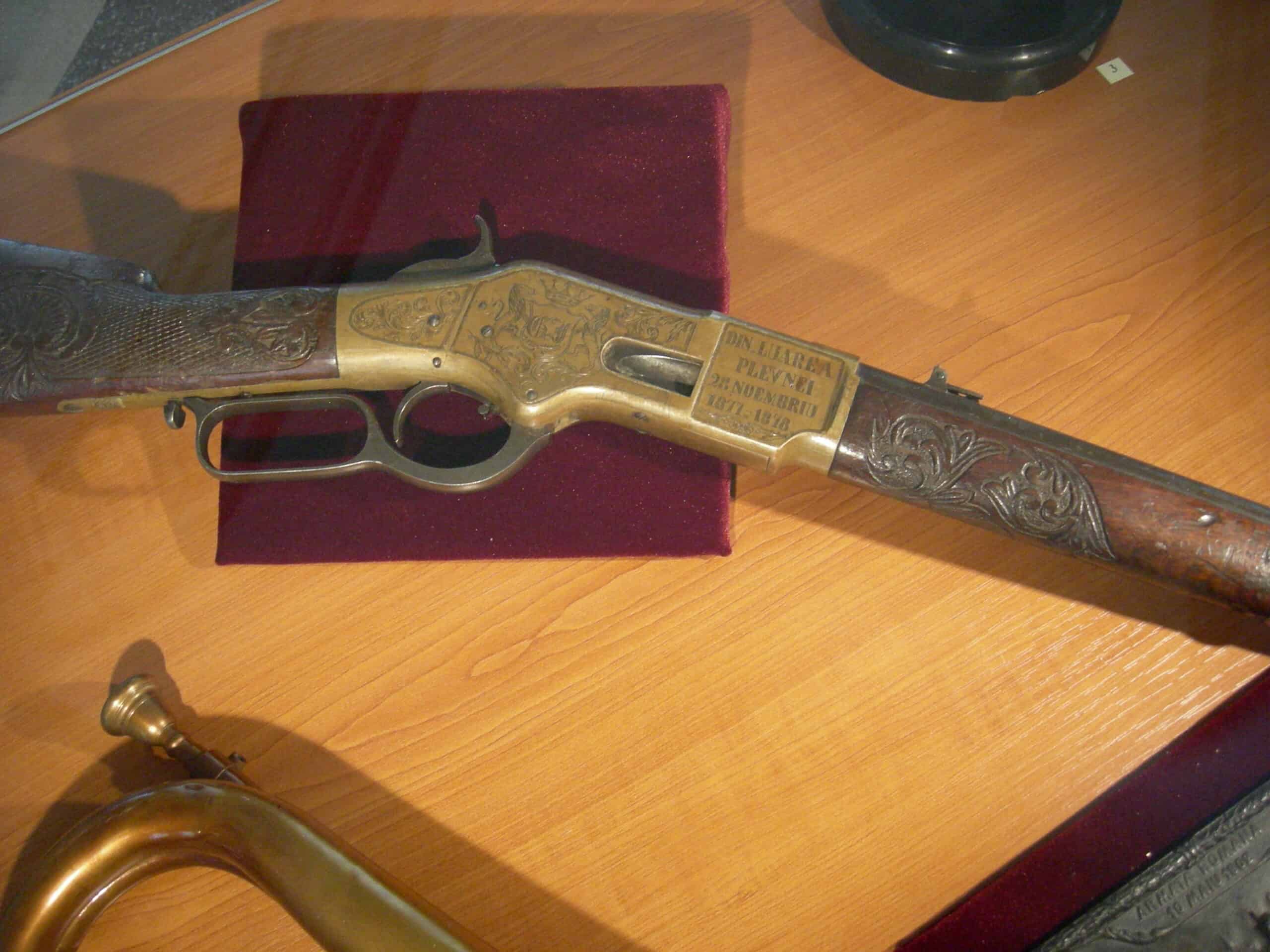
The Winchester name is synonymous with high-quality guns and the Model 1866 Rifle is no exception. It was originally referred to as the “Improved Henry”. The gun was a brass-framed, .44-caliber, lever-action rimfire rifle that was wildly popular with both settlers and Native Americans. Around 170,000 units were produced between 1866 and 1898. The Native Americans loved the gun for its repeating rifle configuration. Native Americans also liked the fact that it had a gorgeous, bright yellow, brass receiver. They referred to it as “Yellowboy.” It used rimfire cartridges, which were not as strong as the more prevalent centerfire cartridges. However, this factor did not impact its popularity.
The gun was carried by many major names in the United States military as well as famous Native Americans. You may recognize some of its most famous wielders, such as General Grenville Dodge, Bill Doolin, Sitting Bull, many members of the Texas Rangers, and the warriors led by Crazy Horse to defeat General Custer’s troops in the disastrous battle of Little Bighorn in June 1876. It was also popular among U.S. Army scouts and various military officers throughout the years. Other users included ranchers and hunters.
Smith & Wesson Model 3 “American” Revolver

This is one of the later guns of the 19th century, introduced in 1870. It was a 0.44-caliber centerfire revolver, and the first practical large-bore, U.S.-made metallic cartridge revolver. This gun was the starting point of engineering for many other highly successful Smith & Wesson models. The 0.44 Russian, the 0.45 Schofield, and the New Model No. 3 Single Action were all based on the original Model 3 “American”. It was highly popular among civilians and the military alike and had a contract with the U.S. Cavalry which issued the gun to their soldiers. It was also a part of the armament carried by the famous Wheeler U.S. Geological Survey of the southwestern United States from 1871–1873.
This gun was also loved by many big names in the Wild West. Famous wielders include William F. “Buffalo Bill” Cody, “Texas Jack” Omohundro, Dallas Stoudenmire, and General William Palmer. The latter would eventually become famous for building the Denver and Rio Grande Railroad. The “Russian” variation of the gun was carried by illustrious wielders, such as John Wesley Hardin, Charlie Pitts, a member of the James-Younger outlaw gang, New Mexico sheriff Pat Garrett, and famed gunman King Fisher.
Colt 1873 Single Action Army
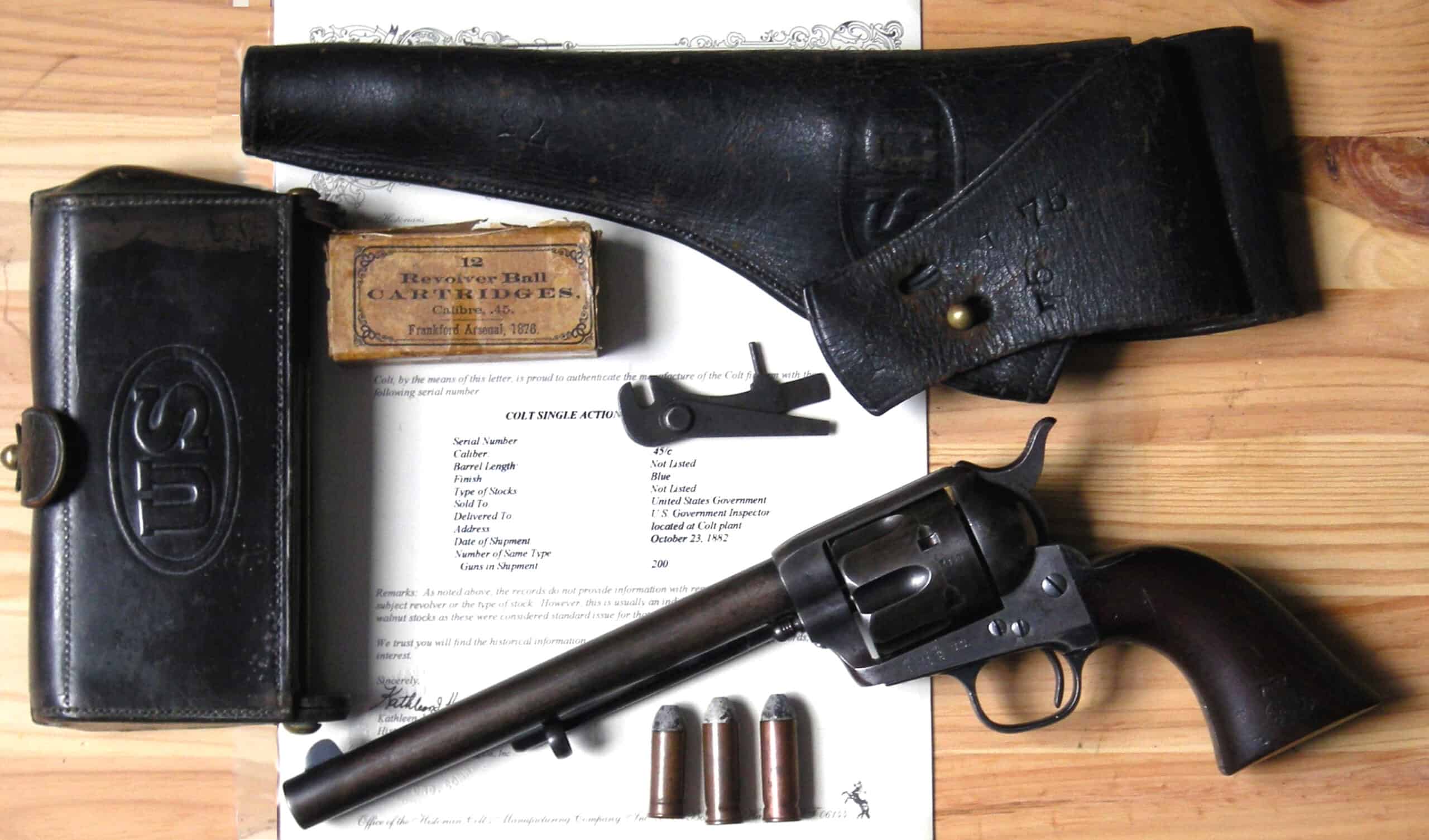
The Colt 1873 Single Action Army is probably the gun you’re thinking of when you think of the Old West, even if you don’t know it by name. It’s one of the most recognizable guns in the world. The mere mention of the Old West probably conjures images of the Colt 1873 Single Action Army. Even if you’re not well-versed in guns, you’ve probably seen this one in a Western flick. It was the single most popular six-shooter of the United States Western frontier. Due to its popularity, it went by many names. The most popular nickname for the gun was the “Peacemaker”. It was also referred to by more colorful names such as the “Equalizer”, “Hogleg”, and “Judge Colt and His Jury of Six”.
One of the primary draws of this six-shooter was that it was chambered with powerful calibers. It took the 0.45 Colt, 0.44-40, and 0.38-40. It outsold all other competitor guns at the time. In total around 192,000 units were produced at the end of the 18th century. This gun was popular with everyone. Lawmen, such as the Texas Rangers and Arizona Rangers, used it. It was popular among those who rode the Owlhoot Trail. Additionally, many Western legends, such as Bat Masterson, the Daltons, Judge Roy Bean, Wyatt Earp, Elfego Baca, and John Selman loved this gun.
This gun is not only popular but also relatively future-proof. So much so that Colt is still producing them to this day, with few changes to the engineering. Nowadays, they fetch a hefty price with a $1,800 price tag to get a new one off the manufacturing line. It makes sense to do so, though. The gun has an elegant, iconic appearance and remains a practical gun even in the modern day.
Winchester 1873 Rifle
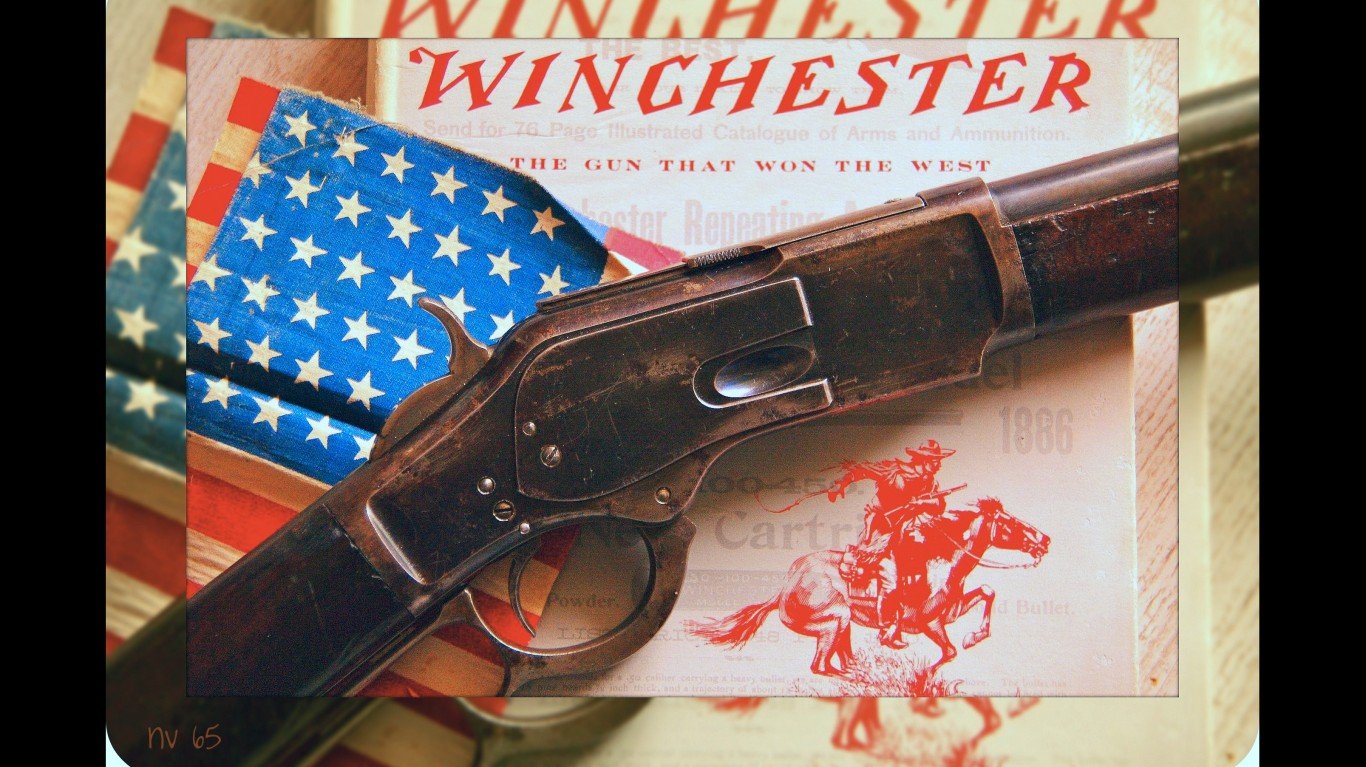
When it comes to famous rifles, the Winchester 1873 is one of the most popular rifles of all time. It’s especially famous when it comes to the Old West. The 1873 Rifle was Winchester’s first centerfire gun. It had a relatively good manufacturing run, lasting from 1873–1919. Production numbers for the gun were massive with 720,000 units produced in total, 525,000 of those were made by 1898.
It was a slab-sided, lever-action rifle that was ideal to use with a saddle scabbard. This design made it excellent for cowboys and cavalrymen. One of the other main draws of the Winchester 1873 Rifle was that the gun’s toggle and link internal action was exceptionally easy to maintain. It didn’t require an excessive amount of tools. This factor made it ideal for soldiers and settlers. They were often away from civilization. Thus, they needed a gun they could maintain without going to the store all the time.
The gun’s chambering was solid. It could take 0.44-40, 0.38-40, and 0.32-30 cartridges. Due to the massive popularity of the gun, Winchester’s calibers became so prevalent that other gun manufacturers started producing revolvers chambered for Winchester caliber cartridges to capitalize on Winchester’s success. This created a practical and favored habit of mating one’s rifle and revolver out on the Western frontier. People would have revolvers and rifles chambered with the same cartridge. This way they could use them interchangeably instead of having to carry twice as many supplies. This gun became the premier choice for the post-1874 Texas Rangers. Other famous users of the gun included William F. “Buffalo Bill” Cody, Granville Stuart, Pat Garrett. It was also wielded by many infamous outlaws like Belle Starr, Butch Cassidy, and the well-known, Billy the Kid.
